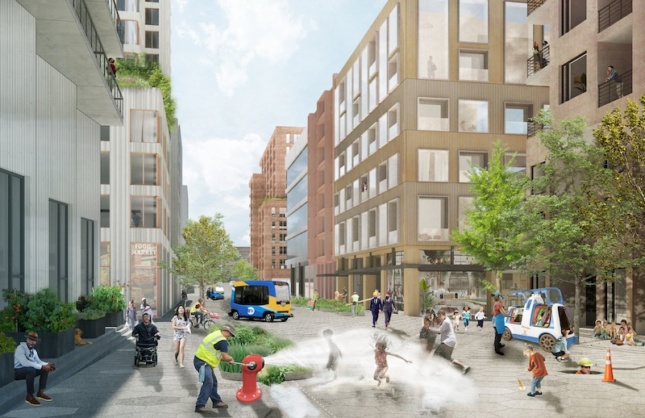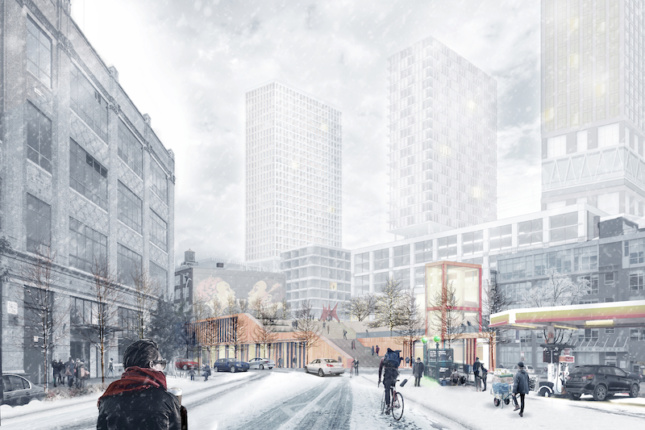The master plan for Sunnyside Yard, the second rail yard-blanketing megadevelopment to take root in New York City in less than a decade, has been unveiled.
But when comparing Sunnyside Yard, in western Queens, to its predecessor, the upmarket enclave Hudson Yards on Manhattan’s far West Side, similarities between the two, aside from their positioning atop active rail yards and their massive size—28 acres for Hudson Yards and a staggering 144 acres for Sunnyside Yard—are far and few between.
When the first of Hudson Yards’ two phases opened in March 2019 seven years after breaking ground, the new neighborhood, studded with skyscrapers designed by an impressive roster of top architects, became an instant magnet for controversy over, among other things, its preponderance of multimillion-dollar condos. (To be clear, there isn’t a total dearth of affordable housing at Hudson Yards.) Sunnyside Yard takes a dramatically different approach, and much-needed affordable housing is at the very core of the sprawling development master-planned by Practice for Architecture and Urbanism (PAU).
In total, Sunnyside Yard will include 12,000 affordable housing units—the most in New York City since Co-Op City in the Bronx was completed in 1973—as the Wall Street Journal reports.

Half of Sunnyside Yard’s apartments will be earmarked as affordable rentals for New Yorkers earning 50 percent below the area median income and the other half reserved for affordable homeownership initiatives. Half of the aforementioned affordable rentals would be reserved for very low-income New York families earning less than 30 percent of the area median income.
In addition to housing, the ground-up carbon-neutral neighborhood, a project of the New York City Economic Development Corp (EDC) co-planned with Amtrak, will include 60 acres of parkland and open public space, multiple libraries, a score of healthcare facilities, and up to a dozen new schools.
“While the overall program is flexible in terms of location and quantities,” explained PAU, “the plan calls for 100 percent affordable housing; a mix of office, retail, light-manufacturing and institutional programs; and lays out an armature of public goods to support these uses.”
While Sunnyside Yard has yet to be slapped with a total price tag, the cost to build a protective deck over most of the 180-acre rail yard partly owned by Amtrak—the master plan encompasses 80 percent of the total site—is estimated at $14.4 billion. This also includes the cost of building out necessary street-level infrastructure, utilities, and more. New Yorkers shouldn’t hold their breaths for a huge influx of affordable housing soon, as the project will take decades to complete, with a new regional transit hub, Sunnyside Station, taking priority over housing in terms of what will come first.
PAU notes that “the team has identified a series of early investments that respond to pressing community needs and could be implemented in the near term.” Sunnyside Station, identified through community engagement as one of the pressing needs, is one of these early investments.

Developers have yet to be selected for the project although the plan gives priority to women- and minority-owned firms and community-centered nonprofits. A consortium composed of Amtrak, the MTA, and the city, along with “community and elected officials will guide the planning process,” wrote the Journal.
Writes PAU:
Encircled by thriving neighborhoods that are both tall and small, artistic and prosaic, diverse and even more diverse, Sunnyside should connect, celebrate, and enhance its surroundings. Like the rest of Queens, with its vast industrial and residential neighborhoods, the World’s Fair grounds, MoMA PS1, the Noguchi Museum, Socrates Sculpture Park, and Gantry Plaza State Park, the ideas for Sunnyside must be diverse, creative, and contemporary. These places—like the future-facing borough they call home that led New York into the Jet Age—have never been about the same old same old, never about nostalgia, and never succumb to the banal. Neither should Sunnyside Yard, which could portend our future as a city.
“It’s unprecedented in the last 50 years and it’s amazing,” Jonathan F.P. Rose, an urban planner and affordable housing developer, told the Journal. “When you combine those things with schools, parks, health care, social services, it creates the platform for people to move forward economically with their lives.”

How Sunnyside Yard will be paid for is a detail that’s yet to be ironed out, and backers of the project admit funding will be an uphill battle moving forward. Cash will likely come from a mix of federal, state, and city resources including affordable housing subsidies and tax-exempt bonds.
Sunnyside Yard recently made news when the project’s EDC-organized steering committee lost Congresswoman Alexandria Ocasio-Cortez and Sylvia White of the Justice for All Coalition as members. Their resignation came after local residents and leaders strongly objected to the project during a months-long public outreach period. Those in opposition believe that the funds that would be allocated by the city to develop and build Sunnyside Yard should instead be used for more urgent community needs.
In her resignation letter, Ocasio-Cortez argued that funds “should be invested in shoring up the existing transportation infrastructure that already exists there or investing it in other under-funded public resources that our community relies on.”


“Sunnyside Yards presents an opportunity to build a stronger New York for generations to come that includes more open space, transit, affordable housing, jobs and green infrastructure in western Queens,” wrote an EDC spokesperson in response. “This planning process has always put community engagement at the center. We’re committed to continuing our work with the community to build a strategic vision that can better serve local residents and all New Yorkers.”
It was first announced that the New York-based PAU had been selected to develop the project master plan in May 2018. Landscape architecture firm Nelson Byrd Woltz and Carlo Ratti Associati are among the collaborators that worked alongside PAU in realizing the vision, which as the Sunnyside Yard executive summary states, is “not a shovel-ready mega-development plan, but rather a long-term framework to guide decisions, ensuring that they are led by public priorities, and centered on human needs.”
“As an architecture firm deeply committed to advancing equitable, ecological, and joyful cities, PAU has been honored to collaborate with the City, Amtrak, the Steering Committee, our extraordinary consulting team, and innumerable local stakeholders on this intensively community-based, long-term vision for Sunnyside Yard,” said Vishaan Chakrabarti, founder of PAU, in a statement. “At over 180 acres, the Yard represents our city’s most significant opportunity to realize shared progressive goals all in a carbon neutral environment that will set a model globally for sustainable urban growth while maintaining a scale and density reflective of Western Queens. Neighboring communities now have a unique opportunity to leverage this Plan to address long-standing needs in terms of transportation, housing, jobs, open space, social infrastructure, and environmental resilience.”
In a 2019 article about Sunnyside Yard, AN editor-in-chief William Menking speculated that “we are more likely to get another version of Hudson Yards on this public land.” Although nothing yet is set in stone, PAU’s ambitious master plan helps to ensure that this won’t be the case.











